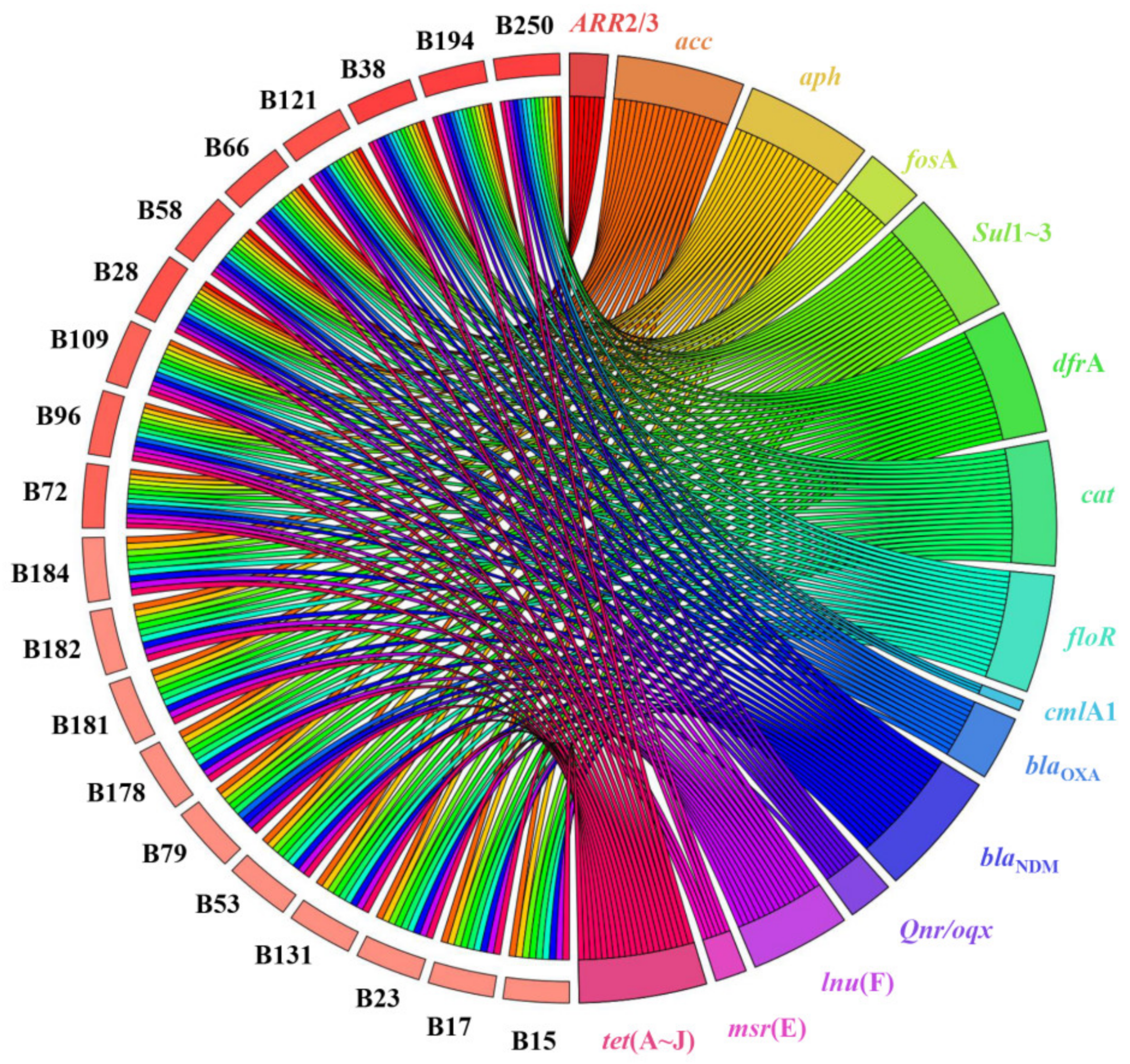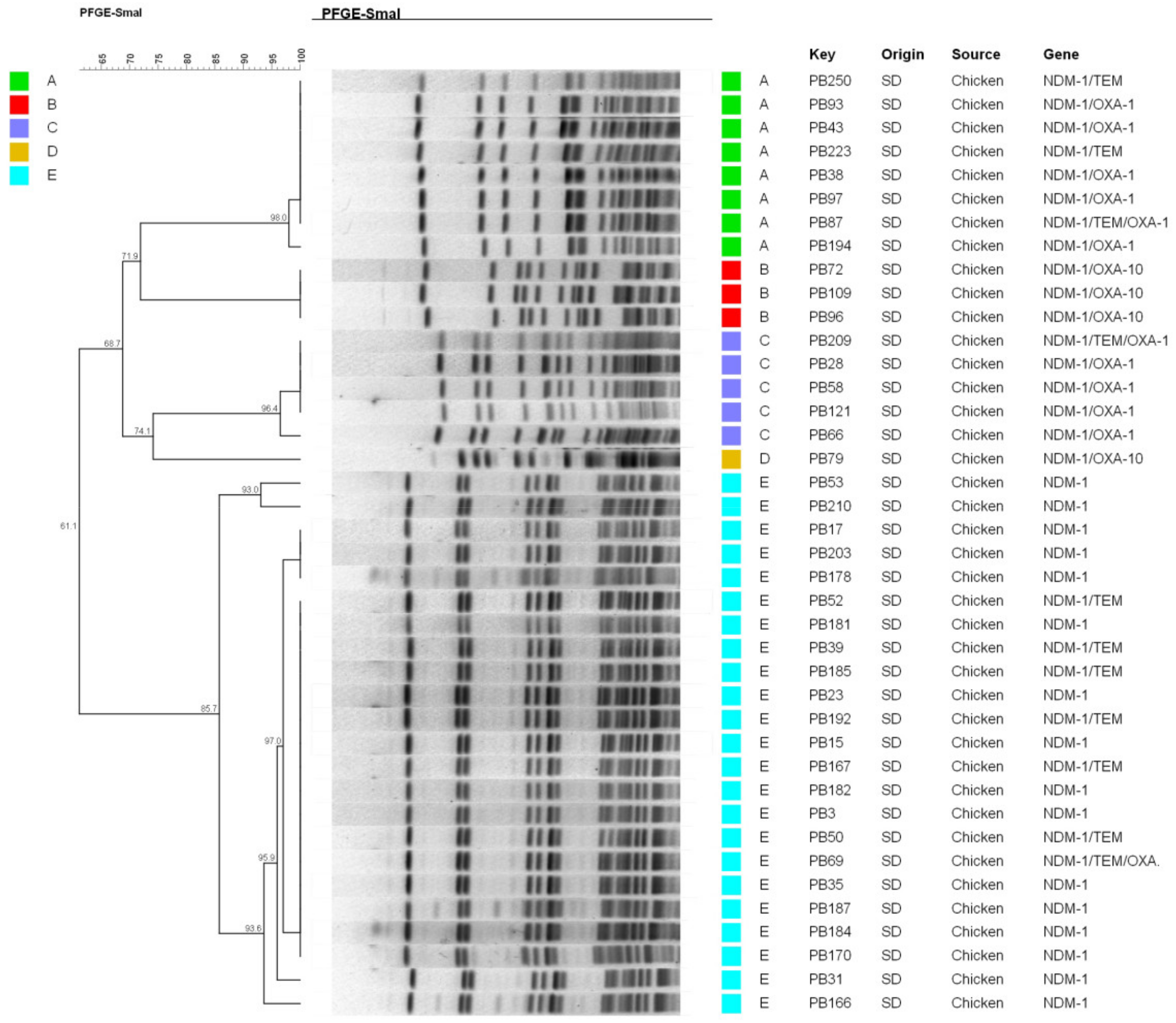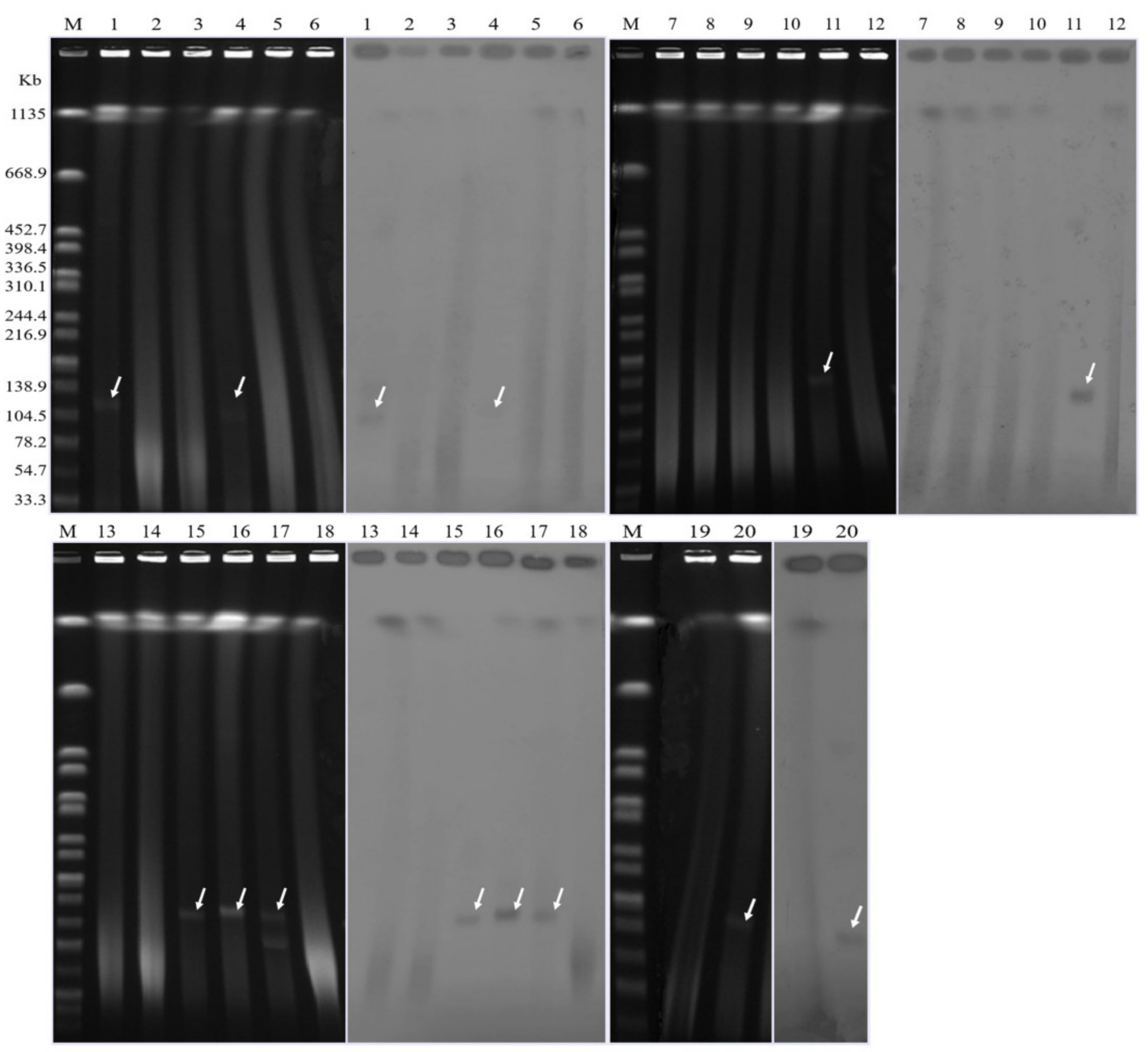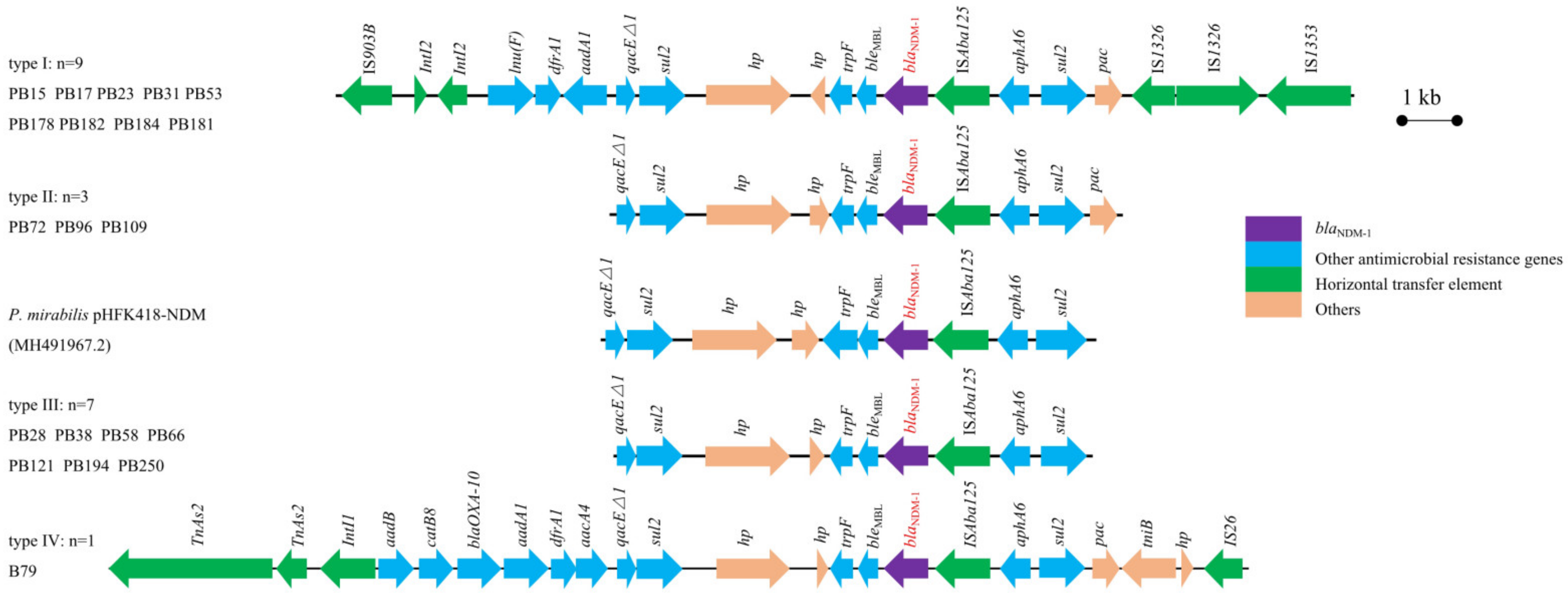Characterization of NDM-1-Producing Carbapenemase in Proteus mirabilis among Broilers in China
Abstract
:1. Introduction
2. Materials and Methods
2.1. Bacterial Isolation, Species Identification and Detection of β-Lactamases Genes
2.2. Antimicrobial Susceptibility Testing
2.3. Pulsed Field Gel Electrophoresis (PFGE)
2.4. S1-PFGE and Southern Hybridization
2.5. Conjugation Assay
2.6. Whole Genome Sequencing (WGS) and Bioinformatics Analysis
3. Results
3.1. Isolation of Strains and Detection of β-Lactamase Genotype
3.2. Antimicrobial Susceptibility
3.3. PFGE Typing and Phylogenetic Analysis
3.4. Transfer and Location of the blaNDM-1 Gene
3.5. Characterization of the blaNDM-1 Genetic Environment
4. Discussion
5. Conclusions
Supplementary Materials
Author Contributions
Funding
Institutional Review Board Statement
Informed Consent Statement
Data Availability Statement
Conflicts of Interest
References
- Gong, Z.L.; Shi, X.L.; Bai, F.; He, X.L.; Zhang, H.Y.; Li, Y.B.; Wan, Y.; Lin, Y.M.; Qiu, Y.Q.; Chen, Q.C.; et al. Characterization of a Novel Diarrheagenic Strain of Proteus mirabilis Associated with Food Poisoning in China. Front. Microbiol. 2019, 10, 2810. [Google Scholar] [CrossRef] [Green Version]
- Chen, C.Y.; Chen, Y.H.; Lu, P.L.; Lin, W.R.; Chen, T.C.; Lin, C.Y. Proteus mirabilis urinary tract infection and bacteremia: Risk factors, clinical presentation, and outcomes. J. Microbiol. Immunol. Infect. 2012, 45, 228–236. [Google Scholar] [CrossRef] [Green Version]
- Lei, C.W.; Zhang, A.Y.; Wang, H.N.; Liu, B.H.; Yang, L.Q.; Yang, Y.Q. Characterization of SXT/R391 Integrative and Conjugative Elements in Proteus mirabilis Isolates from Food-Producing Animals in China. Antimicrob. Agents Chemother. 2016, 60, 1935–1938. [Google Scholar] [CrossRef] [PubMed] [Green Version]
- Kang, Q.; Wang, X.; Zhao, J.N.; Liu, Z.H.; Ji, F.; Chang, H.; Yang, J.C.; Hu, S.J.; Jia, T.; Wang, X.J.; et al. Multidrug-Resistant Proteus mirabilis isolates carrying blaOXA-1 and blaNDM-1 from wildlife in China: Increasing public health risk. Integr. Zool. 2020, 16, 798–809. [Google Scholar] [CrossRef]
- Gebreyes, W.A.; Jackwood, D.; de Oliveira, C.J.B.; Lee, C.W.; Hoet, A.E.; Thakur, S. Molecular Epidemiology of Infectious Zoonotic and Livestock Diseases. Microbiol. Spectr. 2020, 8. [Google Scholar] [CrossRef] [PubMed]
- Dong, D.D.; Li, M.L.; Liu, Z.Z.; Feng, J.T.; Jia, N.; Zhao, H.; Zhao, B.H.; Zhou, T.T.; Zhang, X.L.L.; Tong, Y.G.; et al. Characterization of a NDM-1-Encoding Plasmid pHFK418-NDM From a Clinical Proteus mirabilis Isolate Harboring Two Novel Transposons, Tn6624 and Tn6625. Front. Microbiol. 2019, 10, 2030. [Google Scholar] [CrossRef] [Green Version]
- Potter, R.F.; D’Souza, A.W.; Dantas, G. The rapid spread of carbapenem-resistant Enterobacteriaceae. Drug Resist. Updates 2016, 29, 30–46. [Google Scholar] [CrossRef] [PubMed] [Green Version]
- Guerra, B.; Fischer, J.; Helmuth, R. An emerging public health problem: Acquired carbapenemase-producing microorganisms are present in food-producing animals, their environment companion animals and wild birds. Vet. Microbiol. 2014, 171, 290–297. [Google Scholar] [CrossRef]
- Köck, R.; Daniels-Haardt, I.; Becker, K.; Mellmann, A.; Friedrich, A.W.; Mevius, D.; Schwarz, S.; Jurke, A. Carbapenem-resistant Enterobacteriaceae in wildlife, food-producing, and companion animals: A systematic review. Clin. Microbiol. Infect. 2018, 24, 1241–1250. [Google Scholar] [CrossRef] [Green Version]
- Morrison, B.J.; Rubin, J.E. Carbapenemase producing bacteria in the food supply escaping detection. PLoS ONE 2015, 10, e0126717. [Google Scholar]
- Hooban, B.; Joyce, A.; Fitzhenry, K.; Chique, C.; Morris, D. The role of the natural aquatic environment in the dissemination of extended spectrum beta-lactamase and carbapenemase encoding genes: A scoping review. Water Res. 2020, 180, 115880. [Google Scholar] [CrossRef]
- Falagas, M.E.; Maraki, S.; Karageorgopoulos, D.E.; Kastoris, A.C.; Mavromanolakis, E.; Samonis, G. Antimicrobial susceptibility of multidrug-resistant (MDR) and extensively drug-resistant (XDR) Enterobacteriaceae isolates to fosfomycin. Int. J. Antimicrob. Agents 2010, 35, 240–243. [Google Scholar] [CrossRef] [Green Version]
- Zhanel, G.G.; Golden, A.R.; Zelenitsky, S.; Wiebe, K.; Lawrence, C.K.; Adam, H.J.; Idowu, T.; Domalaon, R.; Schweizer, F.; Zhanel, M.A.; et al. Cefiderocol: A Siderophore Cephalosporin with Activity Against Carbapenem-Resistant and Multidrug-Resistant Gram-Negative Bacilli. Drugs 2019, 79, 271–289. [Google Scholar] [CrossRef] [PubMed]
- Kanzari, L.; Ferjani, S.; Saidani, M.; Hamzaoui, Z.; Jendoubi, A.; Harbaoui, S.; Ferjani, A.; Rehaiem, A.; Boutiba, I.B.B.; Slim, A. First report of extensively-drug-resistant Proteus mirabilis isolate carrying plasmid-mediated blaNDM-1 in a Tunisian intensive care unit. Int. J. Antimicrob. Agents 2018, 52, 906–909. [Google Scholar] [CrossRef] [PubMed]
- Ferreira, E.F.; Beltrão, E.M.B.; da Silva, F.R.F.; Alves, L.C.; Brayner, F.A.; Veras, D.L.; Lopes, A.C.S. Association of blaNDM-1 with blaKPC-2 and aminoglycoside-modifying enzymes genes among Klebsiella pneumoniae, Proteus mirabilis and Serratia marcescens clinical isolates in Brazil. J. Glob. Antimicrob. Resist. 2019, 21, 255–261. [Google Scholar]
- Aires-de-Sousa, M.; Ortiz de la Rosa, J.M.; Goncalves, M.L.; Costa, A.; Nordmann, P.; Poirel, L. Occurrence of NDM-1-producing Morganella morganii and Proteus mirabilis in a single patient in Portugal: Probable in vivo transfer by conjugation. J. Antimicrob. Chemother. 2020, 75, 903–906. [Google Scholar] [CrossRef]
- Bitar, I.; Mattioni Marchetti, V.; Mercato, A.; Nucleo, E.; Anesi, A.; Bracco, S.; Rognoni, V.; Hrabak, J.; Migliavacca, R. Complete Genome and Plasmids Sequences of a Clinical Proteus mirabilis Isolate Producing Plasmid Mediated NDM-1 from Italy. Microorganisms 2020, 8, 339. [Google Scholar] [CrossRef] [Green Version]
- Xie, X.; Zhang, J.; Wang, H.N.; Lei, C.W. Whole genome sequence of a New Delhi metallo-beta-lactamase 1-producing Proteus mirabilis isolate SNYG35 from broiler chicken in China. J. Glob. Antimicrob. Resist. 2021, 24, 266–269. [Google Scholar] [CrossRef]
- Kim, T.W.; Kim, Y.H.; Kim, S.E.; Lee, J.H.; Park, C.S.; Kim, H.Y. Identification and distribution of Bacillus species in doenjang by whole-cell protein patterns and 16S rRNA gene sequence analysis. J. Microbiol. Biotechnol. 2010, 20, 1210–1214. [Google Scholar] [CrossRef] [Green Version]
- Anonymous. Version 10.0. Breakpoint Tables for Interpretation of MICs and Zone Diameters. EUCAST. 2020. Available online: https://www.eucast.org/ (accessed on 23 November 2021).
- Liu, Y.Y.; Wang, Y.; Walsh, T.R.; Yi, L.X.; Zhang, R.; Spencer, J.; Doi, Y.H.; Tian, G.B.; Dong, B.l.; Huang, X.H.; et al. Emergence of plasmid-mediated colistin resistance mechanism MCR-1 in animals and human beings in China: A microbiological and molecular biological study. Lancet Infect. Dis. 2016, 16, 161–168. [Google Scholar] [CrossRef]
- Wu, W.J.; Feng, Y.; Tang, G.M.; Qiao, F.; McNally, A.; Zong, Z.Y. NDM metallo-β-lactamases and their bacterial producers in health care settings. Clin. Microbiol. Rev. 2019, 32, e00115-18. [Google Scholar] [CrossRef] [Green Version]
- Politi, L.; Gartzonika, K.; Spanakis, N.; Zarkotou, O.; Poulou, A.; Skoura, L.; Vrioni, G.; Tsakris, A. Emergence of NDM-1-producing Klebsiella pneumoniae in Greece: Evidence of a widespread clonal outbreak. J. Antimicrob. Chemother. 2019, 74, 2197–2202. [Google Scholar] [CrossRef] [PubMed] [Green Version]
- Zhai, R.D.; Fu, B.; Shi, X.M.; Sun, C.T.; Liu, Z.H.; Wang, S.L.; Shen, Z.Q.; Walsh, T.R.; Cai, C.; Wang, Y.; et al. Contaminated in-house environment contributes to the persistence and transmission of NDM-producing bacteria in a Chinese poultry farm. Environ. Int. 2020, 139, 105715. [Google Scholar] [CrossRef] [PubMed]
- Wang, J.; Yao, X.; Luo, J.; Lv, L.C.; Zeng, Z.L.; Liu, J.H. Emergence of Escherichia coli co-producing NDM-1 and KPC-2 carbapenemases from a retail vegetable, China. J. Antimicrob. Chemother. 2018, 73, 252–254. [Google Scholar] [CrossRef]
- Cui, C.Y.; Chen, C.; Liu, B.T.; He, Q.; Wu, X.T.; Sun, R.Y.; Zhang, Y.; Cui, Z.H.; Guo, W.Y.; Jia, Q.L.; et al. Co-occurrence of Plasmid-Mediated Tigecycline and Carbapenem Resistance in Acinetobacter spp. from Waterfowls and Their Neighboring Environment. Antimicrob. Agents Chemother. 2020, 64, e02502-19. [Google Scholar] [CrossRef]
- Zhang, Q.H.; Lv, L.C.; Huang, X.Y.; Huang, Y.; Zhuang, Z.L.; Lu, J.X.; Liu, E.Y.; Wan, M.; Xun, H.L.; Zhang, Z.W.; et al. Rapid Increase in Carbapenemase-Producing Enterobacteriaceae in Retail Meat Driven by the Spread of the blaNDM-5-Carrying IncX3 Plasmid in China from 2016 to 2018. Antimicrob. Agents Chemother. 2019, 63, e00573-19. [Google Scholar] [CrossRef] [Green Version]
- Williamson, D.A.; Sidjabat, H.E.; Freeman, J.T.; Roberts, S.A.; Silvey, A.; Woodhouse, R.; Mowat, E.; Dyet, K.; Paterson, D.L.; Blackmore, T.; et al. Identification and molecular characterisation of New Delhi metallo-β-lactamase-1 (NDM-1)- and NDM-6-producing Enterobacteriaceae from New Zealand hospitals. Int. J. Antimicrob. Agents 2012, 39, 529–533. [Google Scholar] [CrossRef]
- Sun, L.; Xu, J.; He, F. Genomic characterisation of a Proteus mirabilis clinical isolate from China carrying blaNDM-5 on an IncX3 plasmid. J. Glob. Antimicrob. Resist. 2019, 19, 317–319. [Google Scholar] [CrossRef] [PubMed]
- Valentin, T.; Feierl, G.; Masoud-Landgraf, L.; Kohek, P.; Luxner, J.; Zarfel, G. Proteus mirabilis harboring carbapenemase NDM-5 and ESBL VEB-6 detected in Austria. Diagn. Microbiol. Infect. Dis. 2018, 91, 284–286. [Google Scholar] [CrossRef]
- Bhattacharya, D.; Thamizhmani, R.; Bhattacharya, H.; Sayi, D.S.; Muruganandam, N.; Roy, S.; Sugunan, A.P. Emergence of New Delhi metallo-β-lactamase 1 (NDM-1) Producing and Multidrug Resistant Uropathogens Causing Urinary Tract Infections in Andaman Islands, India. Microb. Drug Resist. 2013, 19, 457–462. [Google Scholar] [CrossRef] [PubMed]
- Villar, H.E.; Danel, F.; Livermore, D.M. Permeability to carbapenems of Proteus mirabilis mutants selected for resistance to imipenem or other β-lactams. J. Antimicrob. Chemother. 1997, 40, 365–370. [Google Scholar] [CrossRef] [Green Version]
- Göttig, S.; Riedel-Christ, S.; Saleh, A.; Kempf, V.A.J.; Hamprecht, A. Impact of blaNDM-1 on fitness and pathogenicity of Escherichia coli and Klebsiella pneumoniae. Int. J. Antimicrob. Agents 2016, 47, 430–435. [Google Scholar] [CrossRef]
- Wang, W.; Baloch, Z.; Peng, Z.X.; Hu, Y.J.; Xu, J.; Fanning, S.; Li, F.Q. Genomic characterization of a large plasmid containing a blaNDM-1 gene carried on Salmonella enterica serovar Indiana C629 isolate from China. BMC Infect. Dis. 2017, 17, 479. [Google Scholar] [CrossRef] [Green Version]
- Zhu, Y.; Liu, W.Y.; Schwarz, S.; Wang, C.Z.; Yang, Q.; Luan, T.; Wang, L.L.; Liu, S.G.; Zhang, W.J. Characterization of a blaNDM-1-carrying IncHI5 plasmid from Enterobacter cloacae complex of food-producing animal origin. J. Antimicrob. Chemother. 2020, 75, 1140–1145. [Google Scholar] [CrossRef] [PubMed]
- Peng, Z.; Li, X.S.; Hu, Z.Z.; Li, Z.G.; Lv, Y.J.; Lei, M.G.; Wu, B.; Chen, H.C.; Wang, X.R. Characteristics of Carbapenem-Resistant and Colistin-Resistant Escherichia coli Co-Producing NDM-1 and MCR-1 from Pig Farms in China. Microorganisms 2019, 7, 482. [Google Scholar] [CrossRef] [PubMed] [Green Version]
- Poirel, L.; Schrenzel, J.; Cherkaoui, A.; Bernabeu, S.; Renzi, G.; Nordmann, P. Molecular analysis of NDM-1-producing enterobacterial isolates from Geneva, Switzerland. J. Antimicrob. Chemother. 2011, 66, 1730–1733. [Google Scholar] [CrossRef] [PubMed] [Green Version]
- DeLeo, F.R.; Chen, L.; Porcella, S.F.; Martens, C.A.; Kobayashi, S.D.; Porter, A.R.; Chavda, K.D.; Jacobs, M.R.; Mathema, B.; Olsen, R.J.; et al. Molecular dissection of the evolution of carbapenem-resistant multilocus sequence type 258 Klebsiella pneumoniae. Proc. Natl. Acad. Sci. USA 2014, 111, 4988–4993. [Google Scholar] [CrossRef] [Green Version]
- Peirano, G.; Bradford, P.A.; Kazmierczak, K.M.; Badal, R.E.; Hackel, M.; Hoban, D.J.; Pitout, J.D.D. Global Incidence of Carbapenemase-Producing Escherichia coli ST131. Emerg. Infect. Dis. 2014, 20, 1928–1931. [Google Scholar] [CrossRef] [PubMed]
- David, S.; Cohen, V.; Reuter, S.; Sheppard, A.E.; Giani, T.; Parkhill, J.; the European Survey of Carbapenemase-Producing Enterobacteriaceae (EuSCAPE) Working Group; the ESCMID Study Group for Epidemiological Markers (ESGEM); Rossolini, G.M.; Feil, E.J.; et al. Integrated chromosomal and plasmid sequence analyses reveal diverse modes of carbapenemase gene spread among Klebsiella pneumoniae. Proc. Natl. Acad. Sci. USA 2020, 117, 25043–25054. [Google Scholar] [CrossRef] [PubMed]
- Duin, D.V.; Doi, Y.H. The global epidemiology of carbapenemase-producing Enterobacteriaceae. Virulence 2016, 8, 460–469. [Google Scholar] [CrossRef] [PubMed]
- Weber, R.E.; Pietsch, M.; Frühauf, A.; Pfeifer, Y.; Martin, M.; Luft, D.; Gatermann, S.; Pfennigwerth, N.; Kaase, M.; Werner, G.; et al. IS26-Mediated Transfer of blaNDM–1 as the Main Route of Resistance Transmission During a Polyclonal, Multispecies Outbreak in a German Hospital. Front. Microbiol. 2019, 10, 2817. [Google Scholar] [CrossRef] [PubMed]
- Adamus-Bialek, W.; Zajac, E.; Parniewski, P.; Kaca, W. Comparison of antibiotic resistance patterns in collections of Escherichia coli and Proteus mirabilis uropathogenic strains. Mol. Biol. Rep. 2013, 40, 3429–3435. [Google Scholar] [CrossRef] [Green Version]
- López, C.; Ayala, J.A.; Bonomo, R.A.; González, L.J. Protein determinants of dissemination and host specificity of metallo-β-lactamases. Nat. Commun. 2019, 10, 3617. [Google Scholar] [CrossRef]
- Potron, A.; Poirel, L.; Nordmann, P. Plasmid-mediated transfer of the blaNDM-1 gene in Gram-negative rods. FEMS Microbiol. Lett. 2011, 324, 111–116. [Google Scholar] [CrossRef] [PubMed] [Green Version]
- Sun, J.; Liao, X.P.; D’Souza, A.W.; Boolchandani, M.; Li, S.H.; Cheng, K.; Martínez, J.L.; Li, L.; Feng, Y.J.; Fang, L.X.; et al. Environmental remodeling of human gut microbiota and antibiotic resistome in livestock farms. Nat. Commun. 2020, 11, 1427. [Google Scholar] [CrossRef] [PubMed] [Green Version]
- McEwen, S.A.; Collignon, P.J. Antimicrobial Resistance: A One Health Perspective. Microbiol. Spectr. 2018, 6. [Google Scholar] [CrossRef] [PubMed] [Green Version]






| Antimicrobial Agent | MIC (mg/L) | ||||||
|---|---|---|---|---|---|---|---|
| CloneA (n = 8) | CloneB (n = 3) | CloneC (n = 5) | CloneD (n = 1) | CloneE (n = 23) | 50% | 90% | |
| Imipenem | 128 | 128 | 128 | 128 | 128 | 128 | 128 |
| Meropenem | 32 | 32 | 32–64 | 32 | 32–64 | 32 | 64 |
| Amoxicillin | >256 | >256 | >256 | >256 | >256 | >256 | >256 |
| Cephalexin | >256 | >256 | >256 | >256 | >256 | >256 | >256 |
| Ceftazidime | >64 | >64 | >64 | >64 | 32->64 | >64 | >64 |
| Ceftriaxone | 16–32 | 16 | 16–32 | 16 | 16–64 | 32 | 32 |
| Cefotaxime | 32 | 32 | 32 | 32 | 32–128 | 32 | 32 |
| Cefepime | 8 | 8 | 8 | 8 | 8 | 8 | 8 |
| Gentamycin | 8 | 32 | 8 | 32 | 4–8 | 8 | 32 |
| Ofloxacin | 0.5 | 2 | 8 | 1 | 0.06 | 0.06 | 8 |
| Aztreonam | 0.03 | 0.03 | 0.03 | 0.03 | 0.03 | 0.03 | 0.03 |
| Strain | MIC (mg/L) | ||||||||||
|---|---|---|---|---|---|---|---|---|---|---|---|
| IPM | MEM | AMX | CEL | CAZ | CRO | CTX | FEP | CN | OFX | ATM | |
| PB72 | 128 | 32 | >256 | >256 | >64 | 16 | 32 | 8 | 32 | 2 | 0.03 |
| PB96 | 128 | 32 | >256 | >256 | >64 | 16 | 32 | 8 | 32 | 2 | 0.03 |
| PB109 | 128 | 32 | >256 | >256 | >64 | 16 | 32 | 8 | 32 | 2 | 0.03 |
| tPB72J | 64 | 8 | >256 | >256 | >64 | 128 | 128 | 8 | 32 | 0.06 | 0.03 |
| tPB96J | 16 | 4 | >256 | >256 | >64 | 32 | 64 | 2 | 32 | 0.06 | 0.03 |
| tPB109J | 128 | 32 | >256 | >256 | >64 | 32 | 64 | 8 | 32 | 0.125 | 0.03 |
| E. coli J53 | 0.25 | 0.06 | 2 | 16 | 0.06 | 64 | 0.06 | 0.06 | 0.06 | 0.06 | 0.03 |
Publisher’s Note: MDPI stays neutral with regard to jurisdictional claims in published maps and institutional affiliations. |
© 2021 by the authors. Licensee MDPI, Basel, Switzerland. This article is an open access article distributed under the terms and conditions of the Creative Commons Attribution (CC BY) license (https://creativecommons.org/licenses/by/4.0/).
Share and Cite
Zhu, X.; Zhang, Y.; Shen, Z.; Xia, L.; Wang, J.; Zhao, L.; Wang, K.; Wang, W.; Hao, Z.; Liu, Z. Characterization of NDM-1-Producing Carbapenemase in Proteus mirabilis among Broilers in China. Microorganisms 2021, 9, 2443. https://doi.org/10.3390/microorganisms9122443
Zhu X, Zhang Y, Shen Z, Xia L, Wang J, Zhao L, Wang K, Wang W, Hao Z, Liu Z. Characterization of NDM-1-Producing Carbapenemase in Proteus mirabilis among Broilers in China. Microorganisms. 2021; 9(12):2443. https://doi.org/10.3390/microorganisms9122443
Chicago/Turabian StyleZhu, Xiaolin, Yaru Zhang, Zhangqi Shen, Lining Xia, Jinquan Wang, Li Zhao, Ke Wang, Wenhui Wang, Zhihui Hao, and Zhihai Liu. 2021. "Characterization of NDM-1-Producing Carbapenemase in Proteus mirabilis among Broilers in China" Microorganisms 9, no. 12: 2443. https://doi.org/10.3390/microorganisms9122443






